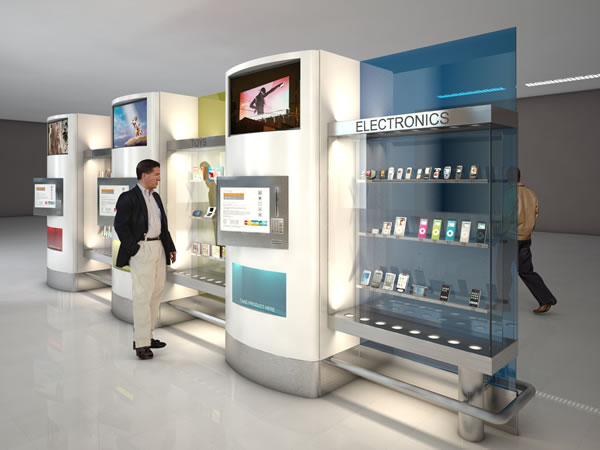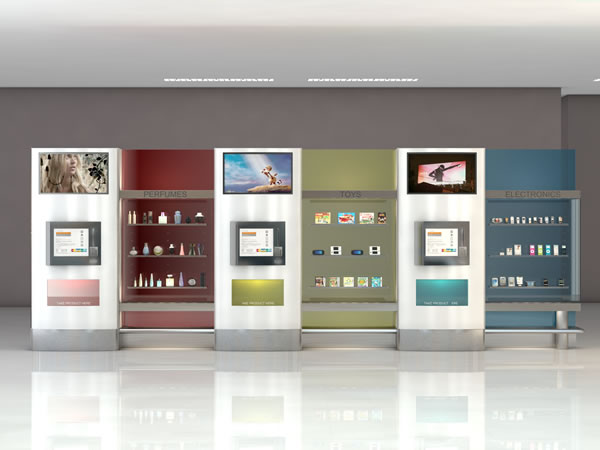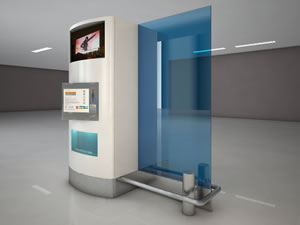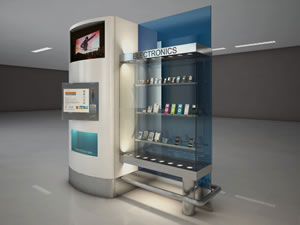THE NETHERLANDS. Automated Retail Concepts wants to revolutionise travel shopping with an innovative new retail model called “˜The Shopping Wall’.
The Amsterdam-based company is run by a team with extensive backgrounds in travel retail, wholesale, design and airport building. They include, Eric van Velzen, former Director of Take Off Multitronics Schiphol, Sheila de Best and Nico Attema, formerly of Dufri International and Theo Spanjaart, the preferred construction partner of Schiphol NV.
The Shopping Wall is a fully automated retail concept based on advanced vending machine technology – with a twist. Automated Retail Concepts Managing Partner Eric van Velzen, who came up with the concept, is quick to differentiate The Shopping Wall from the typical vending machine.
“The Shopping Wall puts the focus on the products and the retail experience instead of on the technique of the vending machine itself – it’s all about emotion,” he stressed.
“So The Shopping Wall is no line-up of vending machines: it is a unique stand-alone fully automated retail shop.”
 |
“It’s all about emotion”: The Shopping Wall puts the focus on the products and the retail experience |
The Shopping Wall aims to put forth a new way of shopping that suits the modern consumer as well as provide retailers with a retail concept that can be added to their existing retail chain.
The idea came about when Van Velzen was travelling through European airports and was struck by the lack of retail facilities at the departure gates. Having arrived early at the gates, he found himself stuck with nothing to do, along with hundreds of other idle passengers. “I found that a shame as there is such a big potential [for retail], and I thought, “˜Why don’t we tap into it?'” he recalled.
The reasons were apparent, given his experience in travel retail. “Retailers are reluctant to spend money building shops at the gates because first of all, there are so many gates. Secondly, the running of the shops cost a lot as well.”
With that he hopped on a plane, where he was struck by another idea. “On that plane, I thought, “˜Why can’t I just buy an iPod from a vending machine? I know what I want – I want an 8GB iPod – and almost like a fairy tale, I took a magazine and I saw an article about Japan and the US$40 billion it earns from vending machines a year. It all came together then.”
While the idea of buying items from a vending machine isn’t new, the execution so far has been fairly poor – a fact that Van Velzen realised in his research of the existing vending machine industry. “I was encouraged and disappointed at the same time by what I saw,” he recalled. “I was encouraged by the fact that in the US and Japan, there is a lot of demand for automated retail, vending machines and self-service. “But the way it was being brought to the public”¦was mainly technology-driven and not from a retail point of view.”
With this in mind Van Velzen decided to redefine the way retailing is handled by a vending machine, starting with the basics. “What’s most important in retail are emotion and the product itself. The product should give you the feeling of “˜I want it and I want it now’,” he explained. To this end the company decided to let the products take centre stage – “we make the product the hero” – and allow customers to browse through them the way they do in a duty free shop, for example.
The result: a sleek and customisable unit that claims to provide a cost-effective retail solution (especially in these difficult economic times) without the problems of staffing and stock losses.
Each machine is made up of two main parts. On the right is a glass showcase where the products are displayed in full view (with no product packaging) and highlighted by spotlights against a coloured glass backdrop. The left hand side comprises the product dispenser, a 32-inch LCD monitor where advertisements can be displayed, and a 19-inch touch screen where customers can browse for detailed product information and pay for their purchases.
 |
The modular concept means it can be configured from one machine and expandable to any number of machines |
HOW IT WORKS: THE SEVEN STEPS TO PURCHASE
1. Using the 19-inch touch screen, the customer receives instructions on how to operate the vending machine with details of the available products
2. The customer selects the desired product(s) and swipes a credit card or direct bank pass and logs into the system
3. If necessary, the customer also scans his boarding pass for customs purposes
4. The customer confirms his choice, pays and the high speed robot lift delivers the product to the dispatcher
5. An optical laser double checks if the product has arrived
6. After this final check the delivery hatch opens automatically
7. Customer removes the product and the receipt is printed
“The Shopping Wall is like buying online, but with direct satisfaction,” said Automated Retail Concepts.
Importantly, the company offers a 100% purchase assurance: if the customer doesn’t receive the product, then no transaction is made. Throughout the entire buying process the customer can get additional information from a FAQ screen or get help from a customer service helpdesk. A web cam is also installed that allows customers to have real-time communication with a customer service officer online via the touch screen.
The Shopping Wall is designed to accommodate a variety of saleable goods such as cameras, electronics, mobile phones, toys and gifts, media (books, CDs and DVDs), watches and sunglasses, as well as travel essentials including drugstore items.
Traditional duty free products can also be sold; however, sealed bag issues for Perfumes & Cosmetics need to be tailored to local circumstances. Depending on the product size (a maximum of 25/25/30cm) and configuration the machine can contain a maximum of 500 products.
 |  |
 |  |
The Shopping Wall is easily assembled and can accommodate a variety of goods such as electronics and mobile phones | |
Because The Shopping Wall is a modular concept, it can be configured from one machine and expandable to any number of machines according to the retailers’ needs. For added flexibility, the machines can be placed within existing shops to increase speed of service at busy times or installed outside the shop to cater customers after closing hours.
The Demo-version of the machine is available for customer presentations from December 2008, and Automated Retail Concepts plans to market The Shopping Wall from the end of the first quarter of 2009. Various travel retail companies have already shown an interest in the Shopping Wall concept, the company said.
For more information, contact Eric van Velzen, tel: +31 20 642 9096, mobile: +31 6 23 190 758, or e-mail: ericvanvelzen@aureco.nl or info@aureco.nl. Visit www.aureco.nl.
ABOUT AUTOMATED RETAIL CONCEPTS
Automated Retail Concepts has its head offices in Amsterdam, The Netherlands where it conducts essential research, development, design and manufacturing.
The shareholders and management all have extensive backgrounds in (travel) retail, wholesale, design and airport building:
• Eric van Velzen: Stap-1 Holding BV, former director Take Off Multitronics Schiphol BV
• Sheila de Best and Nico Attema: SNA Holding, former Sodexho, KLM and Dufri International BV
• Theo Spanjaart: INTOS interiors BV, preferred construction partner of Schiphol NV
[comments]
Your post will appear – once approved – in The Moodie Forum on our home page




